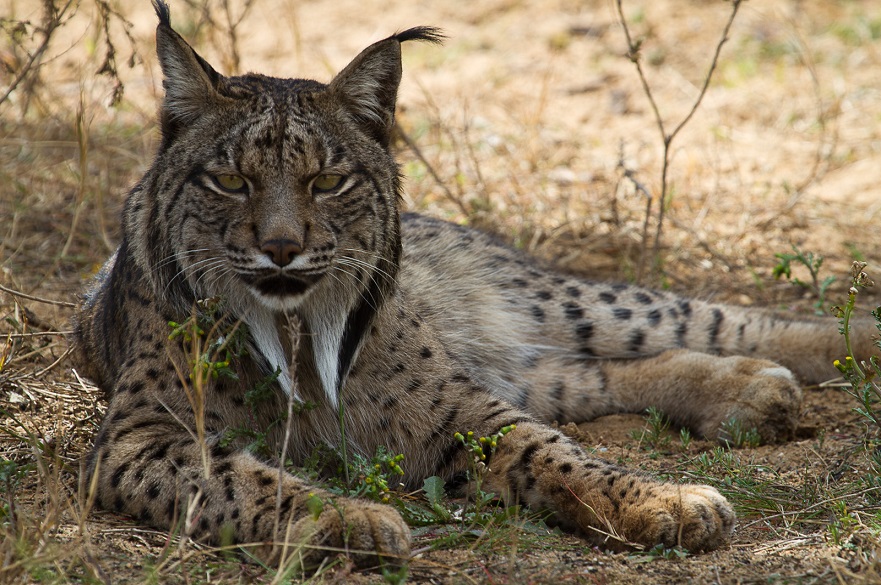Conservation of one of the world’s rarest cat species could be hindered by early nutrition in captivity
The Iberian lynx – one of the world’s rarest cats – undergoes long-term changes to its metabolism that are potentially caused by early nutrition in captivity and could create challenges for the animals once released into the wild, a new study suggests.
By Dave Rogers | Published on 23 April 2020
Categories: Press office; Research; School of Animal, Rural and Environmental Sciences;

Scientists at Nottingham Trent University compared the growth of captive and wild-born Iberian lynx as part of a study to investigate how their environment – including their feeding – might influence their development.
Looking at body weight and food intake in 22 animals, they found that captive-born animals gained weight in association with increasing calorie intake unlike their wild-born counterparts. Moreover, captive-reared females were larger without evidence of obesity.
The team’s findings suggest that early nutrition influences metabolic processes of the animals in later life and may be an adaptive response to enable coping with the environment to which they are exposed after birth.
Writing in the journal Scientific Reports, the researchers propose that their findings could have implications for reintroduction efforts as well as helping to guide how the animals are fed in captivity.
The research team argues that captivity-associated changes to the animals’ metabolism could potentially compromise their survival in the wild upon release.
They contend that an animal with an increased body size will require more food in the wild and could also have a competitive advantage over smaller, wild-born individuals.
A possible outcome is the disruption of the social organisation of existing wild populations, potentially compromising the phenotypic diversity of wild populations.
The work, based on records and inputs from the Iberian Lynx Captive Breeding Centre of El Acebuche in Spain, is thought to be the first study of its kind to show that the level of feeding during pre and post-natal development influences energy requirements in adulthood for an endangered species.
The Iberian lynx is native to Spain and Portugal and there were thought to be fewer than 100 individuals in the wild at the end of the 20th century. This was due to hunting and trapping, bothfor predators as well as the lynx’s staple diet, rabbits.
According to the latest official census, the wild population has recovered to about 700 individuals thanks to conservation efforts. The species has been downgraded from Critically Endangered to Endangered on the IUCN Red List, and is currently on its way to further downgrading.
Part of the success in the recovery of the species is due to the release of 277 captive-born Iberian lynx subadults. These have allowed the expansion of the species through the creation of new populations across the Iberian Peninsula.
The survival rate of the reintroduced individuals is 70%, with road kills and illegal poaching being the main causes of mortality, with others also including disease, territorial fights, and drowning in reservoirs.
“Our study explores the possibility that metabolic programming may be occurring within the captive population of Iberian lynx,” said Dr Katherine Whitehouse-Tedd, a researcher in Nottingham Trent University’s School of Animal, Rural and Environmental Sciences.
The lead author of the study, Ms. Jessica Reeves of the Captive Breeding Centre (El Acebuche), said: “Starvation hasn’t been reported as a direct cause of death, however alteration in the metabolic programming of the reintroduced animals may be affecting the conservation efforts indirectly and requires further investigation.”
Dr Whitehouse-Tedd added: “Since this species is listed as one of the most endangered of all felid species and that captive-bred animals play a key role in reintroduction efforts, this is a vital step forward in our understanding.
“Such metabolic programming raises concern for conservation and population recovery. If faced with a mismatch between captive and wild food availability, the survival of captive-bred lynx upon release could be seriously compromised.
“Given the potential long-term and multi-generational effects of this issue, it is important that we look towards better understanding the effects of developmental programming, which will require more research and could include dietary interventions.”
Notes for Editors
Press enquiries please contact Dave Rogers, Public Relations Manager, on telephone +44 (0)115 848 8782, or via email.
NTU was named University of the Year 2019 in the Guardian University Awards. The award was based on performance and improvement in the Guardian University Guide, retention of students from low-participation areas and attainment of BME students. NTU was also the Times Higher Education University of the Year 2017, and The Times and Sunday Times Modern University of the Year 2018. These awards recognise NTU for its high levels of student satisfaction, its quality of teaching, its engagement with employers, and its overall student experience.
The university has been rated Gold in the Government’s Teaching Excellence Framework – the highest ranking available.
It is one of the largest UK universities. With nearly 32,000 students and more than 4,000 staff located across four campuses, the University contributes £900m to the UK economy every year. With an international student population of more than 3,000 from around 100 countries, the University prides itself on its global outlook
The university is passionate about creating opportunities and its extensive outreach programme is designed to enable NTU to be a vehicle for social mobility. NTU is among the UK’s top five recruiters of students from disadvantaged backgrounds and was awarded University of the Year in the UK Social Mobility Awards 2019. A total of 82% of its graduates go on to graduate entry employment or graduate entry education or training within six months of leaving. Student satisfaction is high: NTU achieved an 87% satisfaction score in the 2019 National Student Survey.
A total of 82% of its graduates go on to graduate entry employment or graduate entry education or training within six months of leaving. Student satisfaction is high: NTU achieved an 87% satisfaction score in the 2019 National Student Survey.